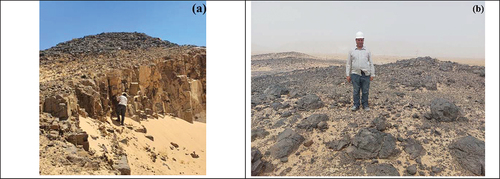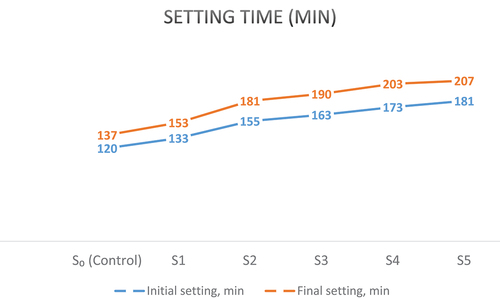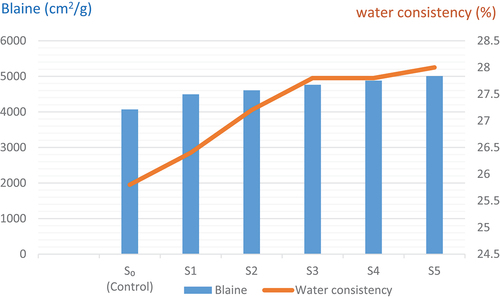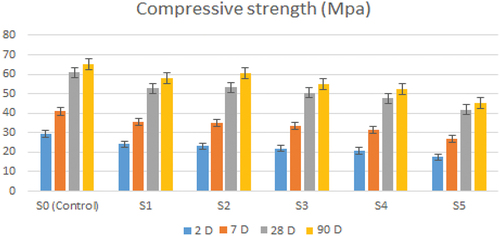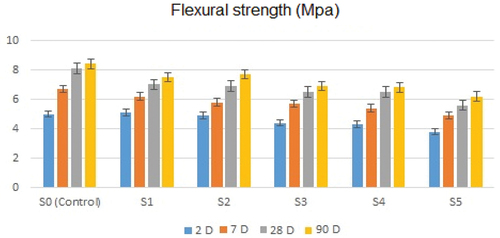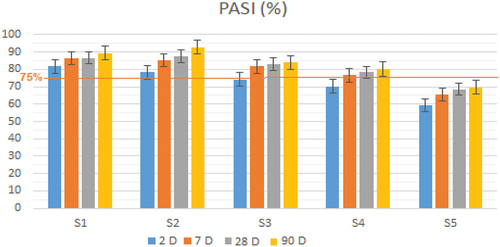ABSTRACT
The cement industry ranks as one of the most significant contributors to carbon emissions among industrial sectors globally. Carbon dioxide (CO2) emissions have the potential to lead to considerable health and economic concerns. CO2 is the second-leading gas after steam, in creating the greenhouse effect. A significant percentage of CO2 emissions in cement plants come from the calcination of limestone to produce clinker. This study examines the impact of partially substituting ordinary Portland clinker with basaltic rocks on the characteristics of the resulting cement. These are employed to mitigate the impact of environmental contamination (CO2 emissions). The studied basaltic rocks were tested to determine the optimal weight percentage replacement. Five mixtures were produced through the partial substitution of clinker with varying proportions of basaltic rocks (10%, 15%, 20%, 25%, and 30%). An investigation was carried out to examine the impact of basaltic rocks on various properties of the produced cement, including workability, setting time, and strength. The parameters were investigated and evaluated by carrying out tests on fresh and hardened mortar specimens at specific time intervals. The results of the investigation lead to the conclusion that the ideal suggested proportion of the studied basaltic rocks as a partial substitute for ordinary Portland clinker is 15%.
Introduction
The cement industry has been highlighted as an important contributor to carbon dioxide emissions; approximately one metric ton of carbon dioxide is released for each metric ton of Portland cement clinker [Citation1–3]. The primary processes responsible for over 90% of the CO2 released during the cement manufacturing process are the calcination process of raw materials and the burning of fossil fuels [Citation4]. To mitigate CO2 emissions from the calcination process, it is necessary to utilize alternate raw materials lacking carbonates in their mineral composition. Currently, no economically feasible minerals that can manufacture cement of equivalent grade to present Portland-based cements have been discovered [Citation5]. Substituting part of the clinker with pozzolanic materials or natural mineral additions may be a suitable alternative after studying its effect on the characteristics of the produced cement. Pozzolana refers to a substance that exhibits the ability to undergo a reaction with calcium hydroxide (Ca(OH)2) at room temperature and under the influence of water [Citation6]. This reaction results in the formation of compounds that possess cementitious properties, such as the C-S-H gel [Citation7]. Pozzolana materials might be directly added to the cement or to Portland clinker during the milling stage. It is commonly employed in the field of concrete to enhance its physical and chemical characteristics, as well as reduce costs and conserve energy [Citation8]. Hence, the utilization of nearby pozzolanic materials as a partial substitute for cement has significant importance due to their cost-effectiveness in comparison to Portland cement and their superior environmental sustainability.
The utilization of pozzolana has several advantages, including the enhancement of the physico-mechanical properties of concrete through its reaction with Ca(OH)2 and the subsequent production of additional cementitious materials. Additionally, it improves the concrete’s resistance to sulfate attack [Citation9–13]. Furthermore, the pozzolana mechanism involves getting inside the cement paste’s pores [Citation14]. The cement industry employs many types of pozzolanic materials, such as natural pozzolana, low calcium fly ash, and silica fume, as well as autopozzolanic resources, including high calcium fly ash and blast furnace slag. Additionally, crystalline materials are utilized as fillers [Citation15,Citation16]. The efficacy of mineral admixtures in blended cements is dependent upon various parameters, including particle size distribution, specific surface area, chemical composition, and crystallinity [Citation17–20].
The utilization of volcanic rocks, including volcanic ash, tuff, pumice, perlite, and basalts, as additives has been reported to provide beneficial characteristics in cement pastes, mortar, and concrete. Consequently, the selection of volcanic rocks has been motivated not only by technical considerations but also by economic and ecological factors [Citation21]. Basaltic rocks are widely recognized as the predominant volcanic igneous rocks found within the Earth’s crust [Citation22]. The composition of the substance mostly consists of calcic plagioclase and pyroxene, accompanied by accessory minerals such as magnetite and ilmenite. Furthermore, certain clay minerals, such as montmorillonite, illite, and vermiculite, may be found as a result of weathering processes. Basaltic rocks are mostly made up of silica, iron, lime and alumina, which constitute their predominant chemical composition. The Egyptian mid-Tertiary basalt is consider as Oligo-Miocene in age and found in extensive deposits that extend across many regions, including Gabal El-Hefhuf, Gabal Mayesra, Gabal Mandisha, Gabal Al-Agouz, Gabal Qatrani, and Abu Rawash in the Western Desert, Naqb Ghul, and Abu Zaabal in the Eastern Desert; and Wadi Nukhul in Sinai [Citation23].
The main aim of this study is to examine the impact of using Egyptian basaltic rocks from the north Sinai as a partial replacement for clinker in order to mitigate CO2 emissions and minimize energy consumption. As a result, the utilization of basaltic rocks as a partial replacement for clinker may decrease the overall expenses associated with the production of mixtures.
Materials and methods
Materials
The investigation utilized Ordinary Portland clinker sourced from the El-Arish cement plant. In addition, locally sourced basaltic rocks have been investigated for use as a partial replacement for clinker. Furthermore, natural gypsum has been utilized as a primary supply of sulfate. Representative basaltic samples have been collected from basaltic exposures near El-Arish Cement Plant and Sinai Cement Plant. The average distance between basaltic flows and both cement plants is about 30 km. The basaltic rocks are located near the main road of Ismailia El-Uga, in North Sinai, Egypt (Al-Hemmah district; ). The basaltic rocks under consideration are primarily associated with volcanic activity that took place throughout the Oligocene to the Early Miocene transition [Citation25–31]. The studied Al-Hemmah basaltic rocks appear to be vertical columnar joints, dark gray to black, hard, and generally fresh (). It also found on top of hills as sheets with different shapes and thicknesses(). Due to weathering processes, they are occasionally pale gray and friable on the surface.
Figure 1. Detailed geologic map of the study area showing location of studied Oligo-Miocene basaltic samples and the location of nearby already existing cement plants (modified after [Citation24]).
![Figure 1. Detailed geologic map of the study area showing location of studied Oligo-Miocene basaltic samples and the location of nearby already existing cement plants (modified after [Citation24]).](/cms/asset/99294aab-dc72-48ba-bedd-c61c53a33570/thbr_a_2298765_f0001_oc.jpg)
Cement preparation
In order to evaluate the impact of using basaltic rocks as a partial substitute for clinker on the characteristics of the resulting cement, the procedures involved milling Ordinary Portland clinker with the inclusion of gypsum and basaltic rocks. This grinding procedure was conducted using a cement grinding machine equipped with iron balls. Six mixtures were designed for the study, namely S₀ control (without basalt), S1, S2, S3, S4, and S5. These combinations, all of which had set gypsum content, are listed in .
Table 1. Composition and proportion of the studied mixes (wt. %).
Characterization of raw materials
Through the use of X-ray fluorescence, the chemical composition of the studied raw materials (clinker, basalt, and gypsum) was examined independently. Clinker phases were calculated according to Bogue’s equations. Meanwhile, the X-ray diffraction technique (XRD) and petrography examination have been applied to identify the mineralogical composition of basaltic rocks. Moreover, reactive silica, free lime, and the soluble salts (Cl− and SO4–) contents have been determined for the studied basaltic rocks at Housing and Building National Research Center (HBRC), Egypt.
Characterization of cement
The produced cement has been characterized in the laboratories of El-Arish Cement Plant in North Sinai, Egypt. By utilizing X-ray fluorescence (XRF), the chemical composition of the final dehydrated cement was determined. The physical tests carried out on the manufactured cement paste sample covered standard consistency, setting time, and soundness (expansion), as described in the standard [Citation32]. In addition, the measurement of cement fineness was conducted using the Blaine air-permeability device as described in standard [Citation33]. In order to determine the mechanical strength of the cement sample, a cement mortar was prepared utilizing the test method outlined in standard [Citation34].
Result and discussion
Characterization of raw materials
Chemical composition
displays the chemical composition of the raw materials, namely clinker, basalt, and gypsum, in addition to the loss on ignition (LOI). The chemical composition of the clinker sample displays that the sample is mainly composed of CaO, SiO2 as well as Al2O3 and Fe2O3. The calculated clinker phases were C3S, C2S, C4AF and C3A in descending order of abundance. The studied basaltic rocks show elevated levels of SiO2 (50.2), Fe2O3 (14.4), Al2O3 (14.22), CaO (10.68), MgO (7.47), and total alkalis content Na2O+ K2O (2.7). The moisture content of the basaltic rocks under investigation is determined to be 0.42%. On the contrary, the gypsum sample analyzed in mostly consists of SO3 (43.74%), and CaO (32.19%), which are the predominant oxides present.
Table 2. The chemical composition of the clinker and the raw materials.
According to [Citation35], the chemical composition of basaltic rocks demonstrates compatibility with the requirements of natural pozzolana materials (). The combined percentage of SiO2 + Al2O3 + Fe2O3 (78.82%) exceeds the minimum requirement of the standard (70%). The sulfur trioxide (SO3) content (0.02%) does not surpass the maximum limit. Additionally, the moisture content is recorded at 0.42%. The loss on ignition is measured at 0.57%, which falls within the acceptable limit.
Table 3. The chemical properties of pozzolana materials according to (35).
Mineralogical composition
X-ray diffraction (XRD) is employed for identifying the mineralogical composition of the basaltic rocks (). The XRD pattern of the basaltic rocks revealed that plagioclase and pyroxene are the predominant minerals. Plagioclase was mainly calcic in composition (anorthite), whereas augite represented the pyroxene group. The clay minerals (kaolinite, illite, and vermiculite) are the main weathering products. Furthermore, a small quantity of quartz and cristobalite were identified.
Microscopic examination
The mineralogical composition of the studied basaltic rocks has been identified using X-ray diffraction (XRD) analysis and subsequently validated using the petrographic observations. The petrographic analysis () reveals that the basaltic rocks predominantly consist of plagioclase (anorthite) and clinopyroxene (augite). Plagioclase (Pl) frequently occurs in the form of small to medium-sized euhedral prismatic crystals. The presence of augite crystals is observed subophitically partially encloses crystals of plagioclase. The primary constituents observed in the examined basalts are plagioclase and pyroxene crystals, which exhibit an intergranular to subophitic texture. Additionally, small quantities of opaque minerals are typically found interspersed between the plagioclase and pyroxene crystals. Additionally, the presence of iron-oxyhydroxide patches and domains with a blood red coloration has been noticed together with the various components of the basaltic rocks.
Figure 4. Photomicrographs of the studied basaltic rocks. (A-B) shows fine to medium prismatic plagioclase crystals (anorthite) and pyroxene phenocryst (augite) in addition to the opaque minerals (PPL -XPL). (C-F) shows the scattering of amorphous, non-crystalline glassy tuffaceous within the basaltic groundmass (PPL -XPL).
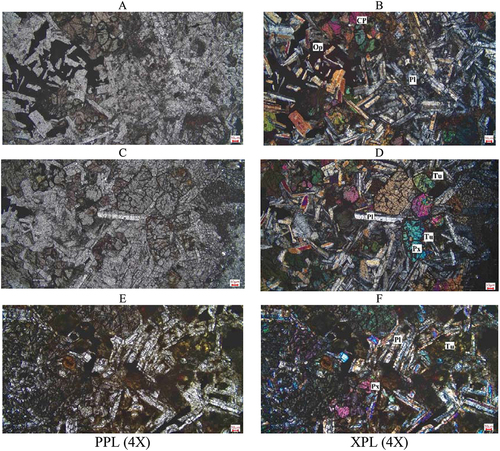
The formation of blood red amorphous iron-oxyhydroxides developed instead of the formation of round and ellipsoid olivine crystals, as reported in earlier research [Citation36]. Furthermore, the formation of glassy tuffaceous material occurs in the form of tiny, irregular patches that develop between the intergranular spaces found between plagioclase and pyroxene crystals. Meanwhile, the presence of glassy tuffaceous material can be clearly recognized under microscopy; there is no detectable amorphous peak seen in the X-ray diffraction (XRD) pattern. This observation refers to the prevalence of volcanic rocks that exhibit varying degrees of crystalline phases. Consequently, the humps of amorphous phases (tuff and glassy materials) cannot be observed in the obtained XRD pattern due to the overlapping nature of the presence of crystalline phases [Citation37–39]. On the other hand, the amorphous content in the studied basalt has been calculated using XRD-match software 3.15. The estimated amorphous content in the studied basaltic rocks was (40 %).
Chemical analysis
Reactive silica, free lime, and the soluble salts (Cl−& SO4–) contents have been determined. Reactive silica content has been determined (38%), which exceeds the minimum requirement (25%) of the standard [Citation40]. The value of measured reactive silica confirms the petrographical examination (glassy tuffaceous phases) and the calculated amorphous content from the XRD chart. It plays an important positive role in the pozzolanic reactivity of the basaltic rocks. Free lime has been determined (traces), within the limits according to [Citation41]. Moreover, the chloride and sulfates contents have been determined according to [Citation42]; (0.004% and 0.045%, respectively) due to their important role in the concrete’s durability. Excessive chloride can lead to a reduction in setting times, an increase in shrinkage, and the corrosion of steel reinforcements. Sulfates in solution can react with the hardened cement paste, leading to expansion and disruption of the concrete.
Physical properties of the studied cement mixes
The impact of basaltic rock addition as a partial replacement for clinker on the physical parameters of blended cement paste is presented in . The initial and final setting time, as shown in , exhibited an overall pattern of rise in cement pastes when the basalt percentage increased. Furthermore, a clear correlation can be observed between the proportion of basaltic rocks in the tested mixtures and the water demand necessary to achieve standard consistency, as depicted in .
Table 4. Physical properties of the blended cement paste for the studied mixes.
The fineness of designed mixes is enhanced as the proportion of basaltic rocks increases, resulting in an increase in the specific surface area of the particles (). One of the primary factors contributing to the observed increase in normal consistency is the proportional increase in the basalt content within the investigated mixtures. Furthermore, the percentage of retained particles (wet-sieve) on the 45 sieve has been measured, with results ranging from 13.7% for the S0 control sample to 9.9% for the S5 sample. The preserved values match up with the fineness (Blaine) of the cement mixtures that were investigated. According to the [Citation35] standard, all of the retained values are located inside the allowed limit of less than 34%. The expansion of the autoclave has been measured and was determined to be within the allowed limit of less than 0.8%, with the exception of S5, which exceeds the allowed limit.
The characteristic of strength has the greatest importance in determining the quality of cement. Three specimens have been tested to measure the strength for each period (2 days, 7 days, 28 days, and 90 days) for each mix. shows the average strength and the pozzolanic activity strength index (PASI) measurements of the cement mixes under investigation over a period of 90 days. demonstrate the connection between the strength of cement mortars and curing time for all hydrated mixes. The compressive strength is found to rise progressively up to a period of 90 days. As the process of hydration progresses, a greater quantity of hydration products and cementitious materials are generated. The decreased amount of free body water through the process of hydrolysis is an essential factor that contributes to the enhancement of compressive strengths in specimens. The hydration interaction between pozzolanic mineral admixtures and the free calcium hydroxide (Ca(OH)2) released leads to the formation of newly formed calcium-silicate-hydrate (C-S-H) products [Citation43]. The compressive strength values of the cement under study exhibit a general trend of being lower than those of the control cement mortar for duration of up to 90 days. Pozzolanic cements don’t provide the same early strength as regular cement due to the insufficient availability of calcium hydroxide during the initial hydration stages [Citation44]. The experimental results demonstrate that the incorporation of the studied basaltic rocks as a substitute for clinker results in a decrease in the compressive strength of mortar across all curing durations.
Table 5. Mortar strength and PASI.
Pozzolanic activity strength index (PASI)
PASI is a widely used criterion for evaluating the pozzolanic properties of a pozzolana in cement and concrete [Citation45]. The PASI is the ratio of the compressive strength of a mortar made with combined cement and a pozzolana to the compressive strength of a control mortar made with cement that does not contain any pozzolana, both subjected to identical curing conditions. The PASI of the studied cement mixes was determined, and the results are presented in . The studied mix labeled S2 has the highest pozzolanic activity index among all the mixes (), suggesting that S2 can be considered the most appropriate mix. To meet the standards set by Chinese Standard [Citation46] and ASTM Standard [Citation35], a pozzolana of superior quality should possess a PASI that surpasses 75% following a 28-day (curing period). Except for the S5 mix, the investigated cement mixes demonstrated pozzolanic activity indices that surpassed the necessary threshold for a high-grade supplementary cementitious material (SCM). Consequently, it can be concluded that these pozzolans possess exceptional quality and are suitable for incorporation in cementitious materials.
Finally, the overview of the physical properties of the studied blended cement demonstrates compatibility with the specifications of natural pozzolana materials (), as indicated by [Citation35].
Table 6. Physical properties of the pozzolana materials according to [Citation35].
Conclusions
A summary of the findings and conclusions is presented as follows: -
The chemical composition of the studied basaltic rocks demonstrates compatibility with the specifications of natural pozzolana materials.
Glassy tuffaceous material occurs as tiny, irregular patches that develop within the groundmass.
The studied basaltic samples have a suitable reactive silica content > 25%.
The physical properties of the studied blended cement demonstrate compatibility with the specifications of natural pozzolana materials except S5.
Basaltic rocks exhibit a relatively limited level of pozzolanic activity in their first stages, which then rises through time.
S2 blended cement mix (15% basalt) shows the optimal suggested cement mix among all studied mixes.
It is recommended to grind the basalt to <20 µm to achieve better physico-mechanical properties in order to react as pozzolanic materials in addition to filler materials.
It is recommended during basaltic quarrying to avoid weathered basalt due to its clay content, which can have a harmful effect on the alkali silica/silicate reactivity.
Acknowledgments
The authors would like to thank El-Arish Cement Company, Sinai, Egypt
Disclosure statement
No potential conflict of interest was reported by the author(s).
References
- Ashraf M, Naeem Khan A, Ali Q, et al. Physico-chemical, morphological and thermal analysis for the combined pozzolanic activities of minerals additives. Constr Build Mater. 2009;23(6):2207–2213. doi: 10.1016/j.conbuildmat.2008.12.008
- Berndt ML. Properties of sustainable concrete containing fly ash slag and recycled concrete aggregate. Constr Build Mater. 2009;23(7):2606–2613. doi: 10.1016/j.conbuildmat.2009.02.011
- El-Didamony M, Helmy HI, Randa M, et al. Basalt as pozzolana and filler in ordinary portland cement. Amer J Engg Appl Sci. 2015;8(2):263–274. doi: 10.3844/ajeassp.2015.263.274
- Mikulčića H, Vujanovića M, Markovskab N, et al. CO2 emission reduction in the cement industry. Chem Eng Trans. 2013;35:703–708. doi: 10.3303/cet.1335117
- Gartner E. Industrially interesting approaches to “low-CO2” cements. Cement Concr Res. 2004;34(9):1489–1498. doi: 10.1016/j.cemconres.2004.01.021
- Thomas MDA, Hooton RD, Scott A, Zibara H. The effect of supplementary cementitious materials on chloride binding in hardened cement paste. Cement Concr Res. 2012;42(1):1–7. doi: 10.1016/j.cemconres.2011.01.001
- Massazza F. Pozzolana and pozzolanic cements. Lea’s Chem Cement Concrete. 2003;471–635. doi: 10.1016/B978-075066256-7/50022-9
- Saraya M. Study physico-chemical properties of blended cements containing fixed amount of silica fume, blast furnace slag, basalt and limestone, a comparative study. Constr Build Mater. 2014;72:104–112. doi: 10.1016/j.conbuildmat.2014.08.071
- Ghrici M, Kenai S, Said M. Mechanical properties and durability of mortar and concrete containing natural pozzolana and limestone blended cements. Cem Concr Compos. 2007;29(7):542–549. doi: 10.1016/j.cemconcomp.2007.04.009
- Yeau K, Kim E. An experimental study on corrosion resistance of concrete with ground granulate blast-furnace slag. Cement Concr Res. 2005;35(7):1391–1399. doi: 10.1016/j.cemconres.2004.11.010
- Shui Z, Zhang R, Chen W, Xuan D. Effects of mineral admixtures on the thermal expansion properties of hardened cement paste. Constr Build Mater. 2010;24(9):1761–1767. doi: 10.1016/j.conbuildmat.2010.02.012
- Hossain KMA, Lachemi M. Performance of volcanic ash and pumice based blended cement concrete in mixed sulfate environment. Cement Concr Res. 2006;36(6):1123–1133. doi: 10.1016/j.cemconres.2006.03.010
- Hossain KMA, Lachemi M. Strength, durability and micro-structural aspects of high performance volcanic ash concrete. Cement Concr Res. 2007;37(5):759–766. doi: 10.1016/j.cemconres.2007.02.014
- De Weerdt K, Ben Haha M, Le Saout G, Kjellsen KO, Justnes H, Lothenbach B. Hydration mechanisms of ternary Portland cements containing limestone powder and fly ash. Cement Concr Res. 2011;41(3):279–291. doi: 10.1016/j.cemconres.2010.11.014
- Martinez-Reyes J, Alavez-Ramírez R, Montes-García P, Jiménez-Quero V. Mineralogical effect on the pozzolanic reactivity of a Mexican lacustrine soil. Constr Build Mater. 2010;24(12):2650–2657. doi: 10.1016/j.conbuildmat.2010.04.059
- Siddique R, Klaus J. Influence of metakaolin on the properties of mortar and concrete: a review. Appl Clay Sci. 2009;43(3–4):392–400. doi: 10.1016/j.clay.2008.11.007
- Massazza F. Pozzolana and pozzolanic cements. In: Hewlett PC, editor. Lea’s chemistry of cement and concrete. Oxford: Butterworth-Heinemann; 2006. p. 471–635.
- Rahhal V, Bonavetti V, Trusilewicz L, Pedrajas C, Talero R. Role of the filler on Portland cement hydration at early ages. Constr Build Mater. 2012;27(1):82–90. doi: 10.1016/j.conbuildmat.2011.07.021
- Jain N. Effect of non-pozzolanic and pozzolanic mineral admixtures on the hydration behavior of ordinary Portland cement. Constr Build Mater. 2012;27(1):39–44. doi: 10.1016/j.conbuildmat.2011.08.006
- Uzal B, Turanlı L, Yücel H, Göncüoğlu MC, Çulfaz A. Pozzolanic activity of clinoptilolite: a comparative study with silica fume, fly ash and a non-zeolitic natural pozzolan. Cement Concr Res. 2010;40(3):398–404. doi: 10.1016/j.cemconres.2009.10.016
- Snellings R, Mertens G, Elsen J. Supplementary cementitious materials. Rev Min Geochem Rev Mineral Geochem. 2012;74(1):211–278. doi: 10.2138/rmg.2012.74.6
- Abdel-Monem AA, Heikal MA. Major element composition, magma type and tectonic environment of the Mesozoic to Recent basalts, Egypt: a review. Bull Fac Earth Sci. 1981;4:121–148.
- Said R, editor. The geology of Egypt. 1st ed. Routledge; 1990. doi: 10.1201/9780203736678
- Abdelhady AA, Kassab W, Aly MF. Shoal environment as a biodiversity hotspot: a case from the Barremian-Albian strata of gabal lagama (North Sinai, Egypt. J Afr Earth Sci. 2019;160:160. doi: 10.1016/j.jafrearsci.2019.103643
- Said R. The geology of Egypt. New York: Elsevier Pub. Co; 1962. p. 337.
- El-Shazly EM, Krs M. Magnetism and palaeomagnetism of oligocene basalts from Abu Zaabal and Qatrani, Northern Egypt. Travaux De Institute Geophysique De V Academie Tchecoslovaque Des Science. 1971;356:261–270.
- Eyal M, Eyal Y, Steinitz G. The tectonic development of the western margin of the Gulf of Elat (Aqaba) rift. Tectonophys. 1981;80(1–4):39–66. doi: 10.1016/0040-1951(81)90141-4
- Moussa HE. Geologic studies and genetic correlation of basaltic rocks in West Central sinai [ PhD thesis]. Fac. Sci., Am Shams University; 1987.
- Roufaiel S, Samuel GM, Meneissy M, et al. K-Ar age determinations of Phanerozoic basaltic rocks in West Central Sinai. Neues Jahrbuch Für Geologie Und Paläontologie - Monatshefte Jg. 1989;1989(11):683–691. doi: 10.1127/njgpm/1989/1989/683
- Scott Baldridge W, Eyal Y, Bartov Y, et al. Miocene magmatism of Sinai related to the opening of the red sea. Tectonophys. 1991;197(2–4):181–201. doi: 10.1016/0040-1951(91)90040-y
- El-Desoky HM, El-Shafey RE. The Oligo – Miocene Volcanism of the Red Sea Rift Valley: Petrology and geochemistry of the volcanic activity in the Northwestern Sinai. Egypt Nature Sci. 2016;14(8):159–185. doi: 10.7537/marsnsj140816.22
- BS EN 196-3. Methods of testing cement - part 3: determination of setting times and soundness; 2016.
- BS EN 196-6. Methods of testing cement part 6: determination of fineness; 2010.
- BS EN 196-1. Methods of testing cement part 1: determination of strength; 2016.
- ASTM C 618-12a. Standard specification for coal fly ash and raw or calcined natural pozzolan for use in concrete; 2013.
- Sonbul AR, Mesaed AA. Petrographic characterization of the different types of basalts of Harrat Al Fatih, Ablah area, West Central Arabian shield, Saudi Arabia. Open J Geol. 2017;7(6):871–887. doi: 10.4236/ojg.2017.76060
- Yu L, Zhou S, Deng W. Pozzolanic activity of volcanic rocks from Southern Jiangxi Province, China. J Sustain Cement-Based Mater. 2015;5(3):176–198. doi: 10.1080/21650373.2015.1010660
- Yu L, Zhou S, Li L. Evaluation of pozzolanic activity of volcanic tuffs from Tibet, China. Adv Cem Res. 2017;29(4):137–146. doi: 10.1680/jadcr.15.00075
- Yu L, Ou H, Lee L. Investigation on pozzolanic effect of perlite powder in concrete. Cement Concr Res. 2003;33(1):73–76. doi: 10.1016/s0008-8846(02)00924-9
- BSEN 8615-1. Specification for pozzolanic materials for use with portland cement. 2019.
- BS EN 451-1. Method of testing fly ash determination of free calcium oxide content. 2017.
- BS EN 1744-1. Tests for chemical properties of aggregates chemical analysis. 2012.
- Itim A, Ezziane K, Kadri E. Compressive strength and shrinkage of mortar containing various amounts of mineral additions. Constr Build Mater. 2011;25(8):3603–3609. doi: 10.1016/j.conbuildmat.2011.03.055
- Saraya M. Stopping of cement hydration by various methods. J HBRC. 2010;6:1–8.
- Yu L, Zhou S, Dong J. Investigation into pozzolanic activity component of basalt and pumice. J Mater Civ Eng. 2020;32(6):04020135. doi: 10.1061/(ASCE)MT.1943-5533.0003180
- Chinese Standard. Mineral admixtures for high strength and high performance concrete. [in Chinese.] GB/T 18736. Beijing: China Standards Press; 2002.

